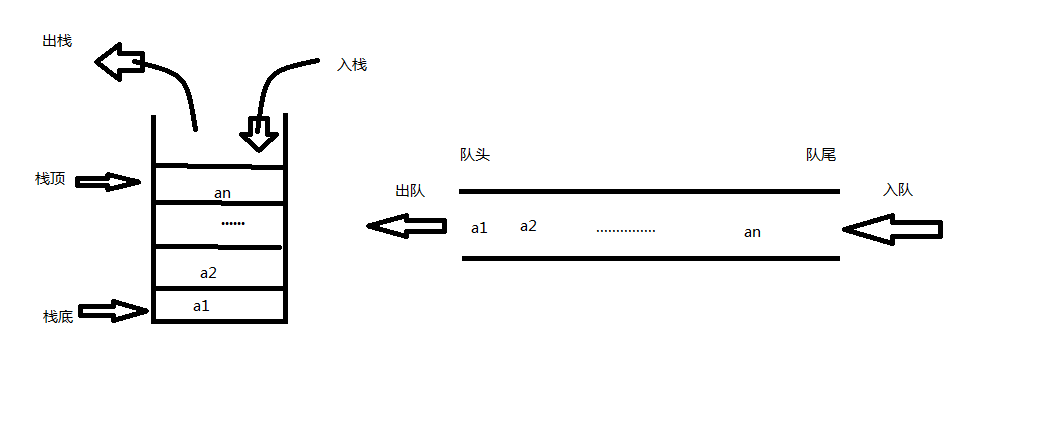1.栈与队列
栈与队列是程序设计中广泛使用的两种重要的线性数据结构。
栈是LIFO(Last In First Out),先存进去的数据只能最后被取出来,进出顺序逆序,即先进后出,后进先出。
队列是FIFO(First In First Out),它保持进出顺序一致,即先进先出,后进后出。

2.如何实现栈

两种方式实现,数组和链表
1 public class MyStack{ 2 3 /* 4 * 用数组实现栈 先进后出,后进先出 5 * 思路:定义一个数组,用来保存入栈的数据,数组初始化大小为10 6 * 用size表示入栈数据的个数 而size-1则是对应的数组下标 7 * (由于是数组,需要考虑扩容的问题) 8 * 入栈时,需要判断数据个数是否超出数组大小,如果超出 使用Arrays.copyOf(,)来扩容 9 * 10 * 出栈时,则直接获取栈顶数据,即根据size-1获取后进的数据元素的数组下标,然后将对应出栈11 * 的数据元素的数组下标处置空。12 * 13 */14 private Object[] stack;15 private int size; //初始化为016 private int newLen;17 18 public MyStack(){19 stack = new Object[10];20 }21 //判读是否栈为空22 public boolean isEmpty(){23 return size==0;24 }25 //查看堆栈顶部的对象,而不将其从堆栈中移除。26 public E peek(){27 if(isEmpty())28 {29 return null;30 }31 return (E)stack[size-1];32 }33 //栈顶元素 出栈34 public E pop(){35 E e = peek();36 stack[size-1]=null;37 size--;38 return e;39 }40 41 //入栈42 public E push(E item){43 ensureCapacity(size+1);44 stack[size++] = item;45 return item;46 }47 //48 private void ensureCapacity(int size) {49 int len = stack.length;50 if(size>len)51 { 52 int newLen = 10;53 //copy stack to newLen+len of length ’s array54 stack = Arrays.copyOf(stack, newLen+len);55 } 56 }57 58 59 public static void main(String[] args) {60 MyStack ms = new MyStack<>();61 System.out.println(ms.size);62 ms.push(1);63 ms.push(2);64 65 System.out.println(ms.size);66 System.out.println("栈顶元素:"+ms.pop());67 System.out.println("栈顶元素:"+ms.pop());68 69 }
1 /* 2 * 使用链表实现栈 先进后出 后进先出 3 * 思路: 栈顶位置top 根据链表 进行前插法 将入栈的元素放在链表头部 4 * 出栈的时候,就直接可以从链表头部取出 5 */ 6 class Node{ 7 Node next = null; 8 E data; 9 Node(E data){10 this.data = data;11 }12 }13 class Stack {14 Node top = null;15 16 //判读是否栈空17 public boolean isEmpty(){18 return top==null;19 }20 //读栈顶元素21 public E peek(){22 if(isEmpty()){23 return null;24 }25 return top.data;26 }27 28 //取出栈顶元素29 public E pop(){30 if(isEmpty()){31 return null;32 }33 E data = top.data;34 top = top.next;35 return data;36 }37 38 39 40 //元素入栈41 public void push(E data){42 Node newNode = new Node (data);43 newNode.next = top;44 top = newNode;45 }46 }
3.如何实现队列
Java中是实现了Queue队列的接口,具体实例化的时候需要用到LinkedList等其他实例化类


使用LinkedList和链表
1 public class MyQueue{ 2 /* 3 * 使用(list)实现队列 先进先出 后进后出 4 * 思路使用LinkedList 本质是双向链表 5 * 入队 链表后插入 6 * 出队 获取链表头部元素 并remove掉 7 */ 8 private LinkedList list = new LinkedList (); 9 private int size ;10 public synchronized void push(E e){11 list.add(e);12 //list.addLast(e);13 size++;14 }15 public synchronized E pop(){16 E e = list.removeFirst();17 size--;18 return e;19 }20 21 public synchronized boolean empty(){22 return size==0;23 }24 25 public synchronized int size(){26 return size;27 }28 29 30 public static void main(String[] args) {31 32 33 MyQueue mq = new MyQueue<>();34 mq.push(4);//35 mq.push(2);36 37 System.out.println(mq.size);38 System.out.println(mq.pop());39 System.out.println(mq.size);40 }41 42 }
class Queue{ Node head = null; Node tail = null; //判读是否队空 public boolean isEmpty(){ if(head == null && tail==null){ return true; } else return false; } //读队头 public E peek(){ if(isEmpty()) return null; return head.data; } //从队头 出队 public E pop(){ if(isEmpty()) return null; E e = head.data; head= head.next; return e; } //进队尾 public void push(E data){ Node newNode = new Node (data); if(head==null && tail == null) { head = newNode; tail = newNode; }else{ tail.next = newNode; tail = newNode; } } //队长 public int size(){ if(head == null) return 0; int len = 1 ; Node l = head; while(l.next!=null){ len++; l = l.next; } return len; } public static void main(String[] args) { //使用链表实现队列 Queue q = new Queue(); q.push(1); q.push(2); q.push(3); System.out.println(q.size()); System.out.println(q.pop()); System.out.println(q.peek()); }}class Node { Node next = null; E data; Node(E data){ this.data = data; }}
4.如何使用两个栈模拟队列操作
1 public class TwoStackForQueue{ 2 3 /* 4 * 用法两个stack 实现队列操作 队列是先进先出的 5 * 思想:设置两个stack A,B, stackA为入队的栈,stackB为出队的栈 6 * 入队直接进栈A,出栈需要判断栈B是否为空,如果为空,需要将栈A中的元素放入栈B中 7 * 如果不为空 直接获取栈B的栈顶元素 8 */ 9 Stack A = new Stack<>();10 Stack B = new Stack<>();11 public static void main(String[] args) {12 TwoStackForQueue queue = new TwoStackForQueue<>();13 queue.put(1);14 queue.put(2);15 queue.put(3);16 // int i = queue.pop();17 // System.out.println(i);18 // i = queue.pop();19 // System.out.println(i);20 // i = queue.pop();21 // System.out.println(i);22 while(!queue.empty()){23 int i = queue.pop();24 System.out.println(i);25 }26 27 }28 //判断是否队空29 public boolean empty(){30 return A.isEmpty() && B.isEmpty();31 }32 33 //出队34 public synchronized E pop(){35 /*if(B.isEmpty()){36 if(A.isEmpty())37 return null;38 while(!A.isEmpty())39 {40 B.push(A.pop());41 }42 return B.pop();43 }44 return B.pop();*/45 //优化46 if(B.isEmpty()){47 while(!A.isEmpty())48 {49 B.push(A.pop());50 }51 }52 return B.pop();53 }54 //入队55 public synchronized void put(E e){56 A.push(e);57 }58 59 60 61 62 }
5.如果使用两个队列模拟栈操作
1 public class TwoQueueForStack{ 2 3 /* 4 * 使用两个队列实现栈 栈的特点是先进后出,后进先出 5 * 思路:两个Queue 使用LinkedList实例化 LinkedList实际上是一个双向链表 6 * q1作为入栈的队列 即直接将入栈的数据放入q1 7 * q2作为出栈的队列 即需要出栈时,如果q1只有一个元素 直接出栈 8 * 如果q1不止一个元素,即可以将q1队列中的数据依次放入q2,最后一个不放入,最后一个元素输出 9 * 再将q2中的元素依次放回q110 */11 private Queue q1 = new LinkedList ();12 private Queue q2 = new LinkedList ();;13 public static void main(String[] args) {14 TwoQueueForStack stack = new TwoQueueForStack<>();15 stack.put(1);16 stack.put(2);17 stack.put(3);18 while(!stack.empty()){19 int i = stack.pop();20 System.out.println(i);21 }22 23 }24 25 //判断是否栈空26 public boolean empty(){27 return q1.isEmpty() && q2.isEmpty();28 }29 30 //出栈31 public synchronized E pop(){32 int size = q1.size();33 if(size==1)34 return q1.poll();35 36 int i=1;37 while(!(i==size)){38 q2.add(q1.poll());39 i++;40 }41 E e = q1.poll();42 43 while(!q2.isEmpty()){44 q1.add(q2.poll());45 }46 return e;47 }48 //入栈49 public synchronized void put(E e){50 q1.add(e);51 }52 53 }